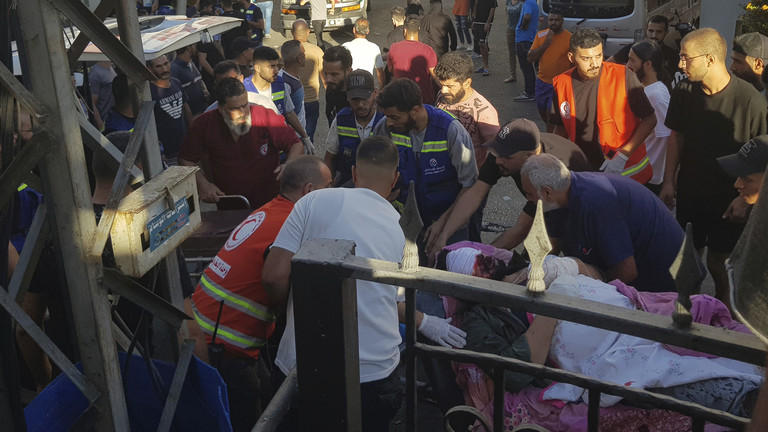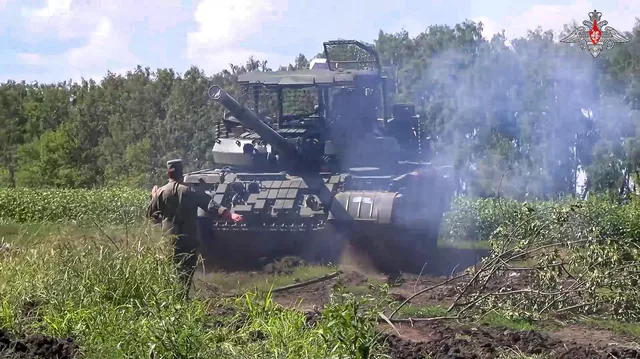20 orang alami luka akibat gempa Bandung Rabu pagi - BPBD Jabar
Badan Meteorologi, Klimatologi, dan Geofisika (BMKG) mendeteksi gempa 5,0 magnitudo mengguncang Kabupaten Bandung, Jawa Barat, Rabu pukul 09.41 WIB.
Dalam peringatan dini yang diekspose melalui sistem aplikasi infoBMKG di Jakarta, Rabu, melaporkan pusat gempa tersebut terletak di darat pada kedalaman 10 kilometer dengan koordinat 7.19 LS,107.67 BT atau berjarak 24 kilometer dari arah tenggara Kabupaten Bandung.
Badan Penanggulangan Bencana Daerah (BPBD) Jawa Barat (Jabar) mengungkapkan untuk sementara dilaporkan 20 orang mengalami luka ringan, sedang, dan berat, akibat gempa bumi yang terjadi di Kabupaten Bandung pada Rabu pagi.
Kasi Kedaruratan Pusdalops BPBD Jabar Hadi Rahmat mengatakan saat ini pihaknya bersama BPBD kabupaten/kota terkait, masih terus melakukan asesmen mengenai jumlah korban dan bangunan yang rusak akibat gempa bumi berkekuatan 5.0 magnitudo pada pukul 09.41 WIB tersebut.
"Sementara ada 20 orang yang luka, dengan satu satu luka ringan, 14 luka sedang, dan lima luka berat, yang dirujuk ke Rumah Sakit Kertasari dan Puskesmas Kertasari," tulis Hadi dalam pesan singkatnya di Bandung, Rabu.
Berdasarkan data yang masuk pukul 12.50 WIB itu, Hadi menyebutkan dampak dari gempa itu terpantau terjadi di Desa Tarumajaya, Cihawuk, dan Cibeureum (Kecamatan Kertasari), kemudian Desa Margamukti (Kecamatan Pangalengan), Desa Cikawao (Kecamatan Pacet); Desa Pinggirsari (Kecamatan Arjasari); dan Desa Bojongmanggu (Kecamatan Pameungpeuk) di Kabupaten Bandung.
Kemudian Desa Barusari, Pasirwangi, Sarimukti, dan Talaga (Kecamatan Pasirwangi), Desa Sirnajaya (Kecamatan Tarogong Kaler), dan Desa Mekarjaya (Kecamatan Sukaresmi) di Kabupaten Garut.
Gempa ini menyebabkan sebanyak delapan rumah, dua fasilitas kesehatan, dua bangunan fasilitas umum, satu sarana pendidikan, dan satu tempat ibadah di Kabupaten Bandung mengalami kerusakan. Sementara di Kabupaten Garut, tujuh rumah dan satu sarana pendidikan rusak.
BPBD Jabar dan BPBD kabupaten/kota terus berkoordinasi melakukan asesmen atas korban dan kerusakan dampak dari gempa itu.
Berdasarkan laporan BPBD Jabar, getaran gempa tersebut terasa mulai dari Kabupaten Bandung, Kota Bandung, Kota Cimahi, Kabupaten Bandung Barat, Kabupaten Garut, bahkan seluruh Jabar.
Gempa yang terasa beberapa detik saja itu, membuat warga di kawasan Bandung Raya sempat panik.
"Gempa dirasakan kuat selama 3-5 detik. Masyarakat panik dan sempat keluar rumah. Kami imbau tenang dan cari tempat aman," ucapnya.
Selain itu, gempa ini juga mengganggu perjalan 11 kereta api yang harus berhenti luar biasa dan pembatalan perjalanan 14 jadwal Kereta Cepat Woosh.
Pemerintah Tetapkan Status Tanggap Darurat Bencana, Whoosh Kembali Beroperasi
Pemerintah Kabupaten Bandung dan Garut menetapkan status tanggap darurat bencana atas terjadinya gempa bermagnitudo 5.0 yang terjadi pada Rabu, 18 September 2024, pukul 09.41 WIB. Sebanyak 491 rumah dan fasilitas umum di Kabupaten Bandung rusak ringan hingga berat, dan di Kabupaten Garut sebanyak 209 bangunan rumah dan fasilitas rusak.
Bupati Bandung Dadang Supriatna mengatakan penetapan status tanggap darurat ini dilakukan untuk mempermudah pemberian bantuan kepada korban dengan menggunakan dana Belanja Tak Terduga (BTT).
“Hari ini juga saya minta untuk diadakan rapat gabungan dengan Forkopimda Kabupaten Bandung untuk memutuskan dalam kategori tanggap darurat sehingga secara anggaran kita bisa luncurkan," kata Dadang di Kabupaten Bandung, Rabu.
Dia menyebutkan pemberlakuan status tanggap darurat bencana akibat gempa ini dilakukan selama dua pekan mulai dari 18 September sampai 2 Oktober 2024.
Dia menambahkan keputusan ini akan membuat pemerintah daerah lebih fokus terhadap penanganan masyarakat yang terdampak oleh bencana tersebut.
“Dan tentunya kita akan panggil semua para kepala dinas yang kaitannya dengan penyelamatan untuk bisa menanggulangi kebencanaan ini,” katanya.
Dia mengatakan hingga saat ini terdapat enam desa terdampak gempa dengan ratusan rumah yang mengalami rusak ringan, rusak berat dan sedang. Ia menyebut korban gempa akan terlebih dahulu dievakuasi.
"Imbauan sementara ini, kita menyiapkan tempat evakuasi. Saya sarankan bagi warga di sekitar Kecamatan Kertasari kalau bisa langsung ke tempat evakuasi yang sudah disediakan oleh tim," kata dia.
Badan Penanggulangan Bencana Daerah (BPBD) Jawa Barat melaporkan jumlah korban luka-luka dari kejadian tersebut berjumlah 82 orang. Mereka yang luka-luka teridentifikasi di Kabupaten Bandung 81 orang, dan satu orang warga Kabupaten Garut.
“Dengan rincian 59 warga mengalami luka ringan dan 23 orang luka berat. Hingga kini tidak ada laporan adanya korban jiwa dampak gempa magnitudo 5.0 tersebut,” kata Humas BPBD Jabar Hadi Rahmat.
Penjabat Bupati Garut Barnas Adjidin mengatakan status tanggap darurat bencana untuk memudahkan penanganan korban selama 14 hari ke depan.
"Tentu ada fase-fase yang harus kita lalui yang pertama fase tanggap darurat, di mana masyarakat itu harus aman dulu, jangan sampai masyarakat tinggal di tempat yang rawan," kata Barnas saat meninjau rumah warga yang terdampak gempa bumi di Desa Barusari, Kecamatan Pasirwangi, Rabu malam.
Barnas bersama jajaran Badan Penanggulangan Bencana Daerah (BPBD) Garut, dan sejumlah instansi lainnya meninjau langsung kondisi bangunan rumah warga yang rusak akibat gempa bumi.
Pemkab Garut, kata Barnas, selanjutnya menetapkan bencana gempa bumi Bandung itu berstatus tanggap darurat, sehingga bisa melakukan langkah untuk membantu penanggulangan warga yang menjadi korban gempa.
"Selama 14 hari kita lihat apa yang bisa dilakukan, dan langkah ke depannya harus bagaimana, terutama perbaikan rumah-rumah," katanya.
Pusat Pengendalian Operasi BPBD Jawa Barat mencatat sampai dengan pukul 15.00 WIB jumlah korban terdampak di Kabupaten Bandung sebanyak 491 keluarga dan 209 keluarga di Garut. Sebanyak 450 orang di Kabupaten Bandung mengungsi di tenda darurat di halaman Kantor Camat Kertasari.
Para korban itu berasal dari Kecamatan Kertasari, Pangalengan, Ibun, Pacet, Arjasari, dan Pameungpeuk, di Kabupaten Bandung. Sementara untuk Kabupaten Garut berasal dari Kecamatan Pasirwangi, Tarogong Kaler, dan Sukaresmi.
Kereta cepat Whoosh kembali beroperasi pada Rabu sore pukul 15.02 WIB setelah 16 jadwal dibatalkan usai gempa mengguncang wilayah Kabupaten Bandung pada pukul 09.41 WIB.
General Manager Corporate Secretary PT Kereta Cepat Indonesia China, Eva Chairunisa, mengatakan mulai pukul 15.02 WIB perjalanan Whoosh dari Stasiun Halim Jakarta dan Tegalluar, Kabupaten Bandung kembali beroperasi setelah pemeriksaan dilakukan dan jalur dinyatakan dapat dilalui dengan kecepatan terbatas.
"Saat ini secara bertahap perjalanan Whoosh Sudah dapat dioperasikan dengan kecepatan terbatas yaitu maksimum 160 kilometer per jam tujuannya untuk lebih memastikan keselamatan perjalanan Whoosh usai pemeriksaan,” kata Eva dalam keterangan yang diterima di Bandung, Rabu. Pada operasi normal, keceatan Whoosh bisa mencapai 350 km per jam.
KCIC menyampaikan permohonan maaf atas ketidaknyamanan yang terjadi setelah sebelumnya beberapa jadwal Whoosh sempat dihentikan sementara akibat gempa susulan yang terjadi di wilayah jalur kereta cepat Whoosh.
“Pemeriksaan ini untuk memastikan tidak ada faktor eksternal yang dapat mengganggu kereta cepat seperti longsoran bukit batu di kanan dan kiri trase, longsoran tanah atau dampak alam lainnya,” kata dia.
Untuk sementara, perjalanan kereta cepat masih melakukan penyesuaian waktu tempuh yakni dari Stasiun Halim menuju Padalarang menjadi 55 menit dan tiba di Tegalluar menjadi 75 menit. Dalam keaadan normal, waktu tempuh Halim-Tegalluar 46 menit.









